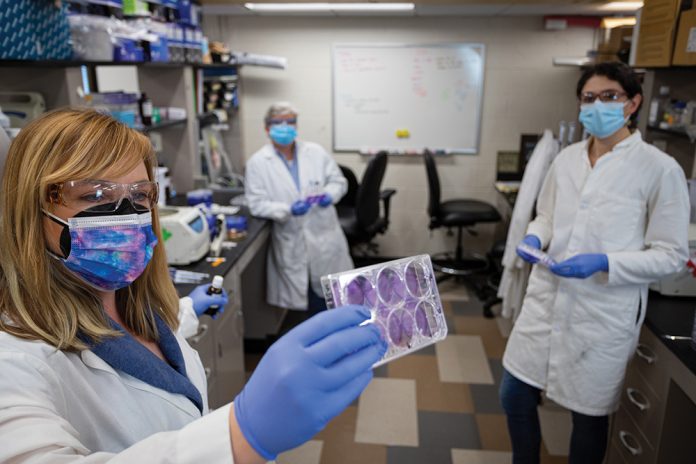The pandemic taught us many things, not least that the airborne transmission of pathogens is a major concern to the public at large and subsequently there has been an increased focus on ventilation and indoor air quality by governments, health agencies and the public alike.
Even with the return to normality, the triple convergence of the flu, respiratory syncytial (RSV) and SARS-CoV-2 (COVID-19) threatening public health, it highlights the need for innovative measures to suppress the spread of these airborne infectious pathogens.
And this is where homegrown Northern innovators Graphene Composites (GC) comes in. A world leader in advanced materials engineering, GC developed a unique nanomaterials coating for air filters GC Halo®, that destroys viruses, bacteria and mould on contact. A graphene oxide/silver nanoparticle formulation, the coating destroys pathogens by forming a ‘trap and kill’ layer on porous materials such as air filters. Air filters that can trap and kill viruses and bacteria in ventilation systems is essentially a new invention – up until now, air filters could only do just that, filter out some of the particles that were carrying these viruses and bacteria.
Aerosol Transmission
Since scientific evidence proves Covid, flu and RSV is predominantly spread indoors through aerosol transmission and its reach is exacerbated by vigorous exhalation, it follows that air filtration and adequate indoor ventilation must feature highly in public health risk-reduction strategies. Air quality is key. Currently, indoor air is mainly controlled by equipment so its temperature and humidity are regulated and odours neutralised. Air may even be purified through HEPA (high efficiency particulate air) filters to remove dust and pollen.
Learning how to clean the air of potentially virus-laden aerosols could have long-term benefits for health and allow businesses and schools to remain open during future outbreaks. A recent editorial in the British Medical Journal states that “we must now confront the neglected, but substantive, role of air in transmitting infection”.
There is a desperate need for affordable, easily implemented solutions to safeguard against airborn pathogens. These approaches will involve living safely with viruses, supported by effective vaccination and booster programmes, rather than their total eradication. The shift away from a pandemic world view to acceptance of endemic diseases whose spread and rates of infection are more predictable will trigger a global need for infrastructures, equipment and environments that can facilitate healthy coexistence with pathogens.
Breakthrough Nanotechnology
The nanotechnology used in GC Halo is highly effective due to the dual-action mechanism: the negatively-charged surface of graphene oxide traps the positively-charged parts of water droplets and the protein spikes on coronavirus and other viruses; the silver nanoparticles oxidize the lipid membrane protecting coronavirus RNA, thereby killing it.
The graphene oxide is supplied by William Blythe, leading chemicals innovator based in Accrington, UK – the quality, stability and purity of their graphene oxide, ensures a highly stable product and William Blythe have recently scaled up their manufacturing facilities for graphene oxide production from lab-scale to a 50-tonne capacity of high purity graphene oxide dispersion product. Partnered with its advanced quality control laboratory and leading process safety know-how, this provides a robust supply of high quality, consistent graphene oxide for the GC-Halo® product, providing significant reassurance for ongoing quality and production in the supply chain.
Fast-acting, safe and more than 99% effective, GC Halo has been independently verified by global leading laboratories including a recent Eureka project, to provide long-lasting protection with broad applications where health, safety, and wellbeing are paramount.
Pivoting in the pandemic
When Covid-19 struck in March 2020, GC was engaged on extending some promising research by Professor Bob Hurt at Brown University on graphene oxide formulations to prevent mosquito bites. With the pandemic taking root, this work was quickly diverted and expanded to develop a coronavirus-killing ink formulation. By adding silver nanoparticles – a proven antibacterial agent – to the graphene oxide formulation, GC aimed to develop a virucidal graphene oxide/silver nanoparticle ink that could kill (or, in technical terms, neutralize) the SARS-CoV-2 coronavirus that causes Covid-19.
Life and death R&D – developing our coronavirus-killing ink
Cramming an estimated three years’ worth of R&D into one year, GC fostered a close and collaborative partnership with Brown University who undertook the virucidal efficacy testing and the UK Centre for Process Innovation (CPI) in Sedgefield, UK who assisted with the formulations work.
By the end of an exhausting 2020, GC had developed a graphene oxide/silver nanoparticle formulation that Brown University had tested to show 100% virucidal efficacy in one minute versus Human Coronavirus OC43 and Influenza A H1N1 virus in liquid form. Brown published this report on the bioRxiv preprint server in March 2021.
The road to commercialistion
Commercialisation of GC Halo has begun with first customers in SE Asia and expansion plans into the Middle East. In other regions, such as Europe and the US, regulatory approval processes with longitudinal studies mean bringing this technology to market is a long-game. By its nature, GC Halo is seen as a biocide or pesticide and existing regulatory and testing regimes are not designed to handle revolutionary technology like this – this is the next set of hurdles for innovators and governing bodies.
GC are now exploring the potential to extend the GC Halo product into other areas. GC Halo® is a registered trademark in the United Kingdom. Details at gc-halo.com.











